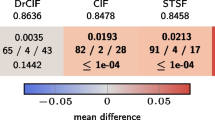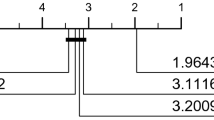Abstract
The Random Interval Spectral Ensemble (RISE) is a recently introduced tree based time series classification algorithm, in which each tree is built on a distinct set of Fourier, autocorrelation and partial autocorrelation features. It is a component in the meta ensemble HIVE-COTE [9]. RISE has run time complexity of \(O(nm^2)\), where m is the series length and n the number of train cases. This is prohibitively slow when considering long series, which are common in problems such as audio classification, where spectral approaches are likely to perform better than classifiers built in the time domain. We propose an enhancement of RISE that allows the user to specify how long the algorithm can have to run. The contract RISE (c-RISE) allows for check-pointing and adaptively estimates the time taken to build each tree in the ensemble through learning the constant terms in the run time complexity function. We show how the dynamic approach to contracting is more effective than the static approach of estimating the complexity before executing, and investigate the effect of contracting on accuracy for a range of large problems.
Access this chapter
Tax calculation will be finalised at checkout
Purchases are for personal use only
Similar content being viewed by others
References
Bagnall, A., et al.: The UEA multivariate time series classification archive, 2018. ArXiv e-prints arXiv:1811.00075 (2018). http://arxiv.org/abs/1809.06705
Bagnall, A., Lines, J., Bostrom, A., Large, J., Keogh, E.: The great time series classification bake off: a review and experimental evaluation of recent algorithmic advances. Data Min. Knowl. Disc. 31(3), 606–660 (2017)
Bagnall, A., Lines, J., Hills, J., Bostrom, A.: Time-series classification with COTE: The collective of transformation-based ensembles. IEEE Trans. Knowl. Data Eng. 27, 2522–2535 (2015)
Breiman, L.: Random forests. Mach. Learn. 45(1), 5–32 (2001)
Brown, A.E., Yemini, E.I., Grundy, L.J., Jucikas, T., Schafer, W.R.: A dictionary of behavioral motifs reveals clusters of genes affecting caenorhabditis elegans locomotion. Proc. Natl. Acad. Sci. 110(2), 791–796 (2013)
Deng, H., Runger, G., Tuv, E., Vladimir, M.: A time series forest for classification and feature extraction. Inf. Sci. 239, 142–153 (2013)
Lines, J., Bagnall, A.: Time series classification with ensembles of elastic distance measures. Data Min. Knowl. Disc. 29, 565–592 (2015)
Lines, J., Davis, L., Hills, J., Bagnall, A.: A shapelet transform for time series classification. In: Proceedings of the 18th ACM SIGKDD International Conference on Knowledge Discovery and Data Mining (2012)
Lines, J., Taylor, S., Bagnall, A.: Time series classification with HIVE-COTE: the hierarchical vote collective of transformation-based ensembles. ACM Trans. Knowl. Discov. Data 12(5) (2018)
Schäfer, P.: The BOSS is concerned with time series classification in the presence of noise. Data Min. Knowl. Disc. 29(6), 1505–1530 (2015)
Yemini, E., Jucikas, T., Grundy, L., Brown, A., Schafer, W.: A database of caenorhabditis elegans behavioral phenotypes. Nat. Methods 10, 877–879 (2013)
Acknowledgements
This work is supported by the Biotechnology and Biological Sciences Research Council [grant number BB/M011216/1], and the UK Engineering and Physical Sciences Research Council (EPSRC) [grant number EP/M015807/1]. The experiments were carried out on the High Performance Computing Cluster supported by the Research and Specialist Computing Support service at the University of East Anglia and using a Titan X Pascal donated by the NVIDIA Corporation.
Author information
Authors and Affiliations
Corresponding author
Editor information
Editors and Affiliations
Rights and permissions
Copyright information
© 2019 Springer Nature Switzerland AG
About this paper
Cite this paper
Flynn, M., Large, J., Bagnall, T. (2019). The Contract Random Interval Spectral Ensemble (c-RISE): The Effect of Contracting a Classifier on Accuracy. In: Pérez García, H., Sánchez González, L., Castejón Limas, M., Quintián Pardo, H., Corchado Rodríguez, E. (eds) Hybrid Artificial Intelligent Systems. HAIS 2019. Lecture Notes in Computer Science(), vol 11734. Springer, Cham. https://doi.org/10.1007/978-3-030-29859-3_33
Download citation
DOI: https://doi.org/10.1007/978-3-030-29859-3_33
Published:
Publisher Name: Springer, Cham
Print ISBN: 978-3-030-29858-6
Online ISBN: 978-3-030-29859-3
eBook Packages: Computer ScienceComputer Science (R0)




